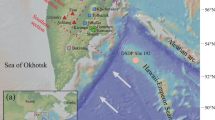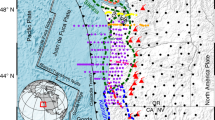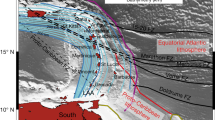Abstract
Aqueous fluids released from subducting plates play an important role in magma generation in many arc settings1,2,3,4. However, different hypotheses have been proposed for the origin of these fluids, the extent to which they mix with the mantle wedge and spatial variations in their composition2,3,4, especially at complex settings involving more than one subducting plate. Central Japan is one such setting, where the Pacific and Philippine Sea plates subduct underneath the North American and Eurasian plates and cause extensive arc magmatism to the west and north of Tokyo. Here, we use geochemical data for rocks from 28 Quaternary volcanoes in central Japan to quantify the relative contribution of fluids originating from the two subducting plates and their spatial distribution. We find that the fluid originating from the Philippine Sea plate is chemically distinct and its flux is localized, as compared with the larger-scale flux from the Pacific plate. In the regions where these two plates overlap, the Philippine Sea plate does not seem to significantly inhibit fluid flow from the Pacific plate below; instead, this geometry leads to enhanced fluid flux. Regional variations in fluid flux and composition are controlled primarily by the geometry and configuration of the subducting plates.
This is a preview of subscription content, access via your institution
Access options
Subscribe to this journal
Receive 12 print issues and online access
$259.00 per year
only $21.58 per issue
Buy this article
- Purchase on Springer Link
- Instant access to full article PDF
Prices may be subject to local taxes which are calculated during checkout




Similar content being viewed by others
References
Arculus, R. J. & Powell, R. Source component mixing in the regions of arc magma generation. J. Geophys. Res. 91, 5913–5926 (1986).
Taylor, R. N. & Nesbitt, R. W. Isotopic characteristics of subduction fluids in an intra-oceanic setting, Izu-Bonin Arc, Japan. Earth Planet. Sci. Lett. 164, 79–98 (1998).
Ishikawa, T. & Nakamura, E. Origin of the slab component in arc lavas from across-arc variation of B and Pb isotopes. Nature 370, 205–208 (1994).
Moriguti, T., Shibata, T. & Nakamura, E. Lithium, boron and lead isotope and trace element systematics of Quaternary basaltic volcanic rocks in Northeastern Japan: Mineralogical controls on slab-derived fluid composition. Chem. Geol. 212, 81–100 (2004).
Workman, R. K. & Hart, S. R. Major and trace element composition of the depleted MORB mantle (DMM). Earth Planet. Sci. Lett. 231, 53–72 (2005).
Iwamori, H. Transportation of H2O and melting in subduction zones. Earth Planet. Sci. Lett. 160, 65–80 (1998).
Iwamori, H. Deep subduction of H2O and deflection of volcanic chain towards backarc near triple junction due to lower temperature. Earth Planet. Sci. Lett. 181, 41–46 (2000).
Hauff, F., Hoernle, K. & Schmidt, A. Sr–Nd–Pb composition of Mesozoic Pacific oceanic crust (Site 1149 and 801, ODP Leg 185): Implications for alteration of ocean crust and the input into the Izu-Bonin-Mariana subduction system. Geochem. Geophys. Geosyst. 4, 10.1029/2002GC000421 (2003).
Kelley, K. A., Plank, T., Ludden, J. & Staudigel, H. Composition of altered oceanic crust at ODP Sites 801 and 1149. Geochem. Geophys. Geosyst. 4, 10.1029/2002GC000435 (2003).
Shimoda, G., Tatsumi, Y., Nohda, S., Ishizaka, K. & Jahn, B. M. Setouchi high-Mg andesites revisited: Geochemical evidence for melting of subducting sediments. Earth Planet. Sci. Lett. 160, 479–492 (1998).
Hickey-Vargas, R. Isotope characteristics of submarine lavas from the Philippine Sea—Implications for the origin of arc and basin magmas of the Philippine tectonic plate. Earth Planet. Sci. Lett. 107, 290–304 (1991).
Tatsumi, Y., Hamilton, D. L. & Nesbitt, R. W. Chemical characteristics of fluid phase released from a subducted lithosphere and origin of arc magmas—Evidence from high-pressure experiments and natural rocks. J. Volcano. Geotherm. Res. 29, 293–309 (1986).
Aizawa, Y., Tatsumi, Y. & Yamada, H. Element transport by dehydration of subducted sediments: Implication for arc and ocean island magmatism. Island Arc 8, 38–46 (1999).
Kogiso, T., Tatsumi, Y. & Nakano, S. Trace element transport during dehydration processes in the subducted oceanic crust.1. Experiments and implications for the origin of ocean island basalts. Earth Planet. Sci. Lett. 148, 193–205 (1997).
You, C. F., Castillo, P. R., Gieskes, J. M., Chan, L. H. & Spivack, A. J. Trace element behavior in hydrothermal experiments: Implications for fluid processes at shallow depths in subduction zones. Earth Planet. Sci. Lett. 140, 41–52 (1996).
Kawakatsu, H. & Watada, S. Seismic evidence for deep-water transportation in the mantle. Science 316, 1468–1471 (2007).
Nakajima, J. & Hasegawa, A. Subduction of the Philippine Sea plate beneath southwestern Japan: Slab geometry and its relationship to arc magmatism. J. Geophys. Res. 112, B08306 (2007).
Iidaka, T. et al. The upper boundary of the Philippine Sea plate beneath the western Kanto region estimated from S-P-converted wave. Tectonophysics 179, 321–326 (1990).
Sekiguchi, S. A new configuration and an aseismic slab of the descending Philippine Sea plate revealed by seismic tomography. Tectonophysics 341, 19–32 (2001).
Matsubara, M., Hayashi, H., Obara, K. & Kasahara, K. Low-velocity oceanic crust at the top of the Philippine Sea and Pacific plates beneath the Kanto region, Central Japan, imaged by seismic tomography. J. Geophys. Res. 110, B12304 (2005).
Iwamori, H. & Zhao, D. Melting and seismic structure beneath the Northeast Japan Arc. Geophys. Res. Lett. 27, 425–428 (2000).
Ono, S. Stability limits of hydrous minerals in sediment and mid-ocean ridge basalt compositions: Implications for water transport in subduction zones. J. Geophys. Res. 103, 18253–18267 (1998).
Kawate, S. & Arima, M. Petrogenesis of the Tanzawa plutonic complex, central Japan: Exposed felsic middle crust of the Izu-Bonin-Mariana arc. Island Arc 7, 342–345 (1998).
Seno, T. & Yamazaki, T. Low-frequency tremors, intraslab and interplate earthquakes in Southwest Japan—From a viewpoint of slab dehydration. Geophys. Res. Lett. 30, 10.1029/2003GL018349 (2003).
Kersting, A. B., Arculus, R. J. & Gust, D. A. Lithospheric contributions to arc magmatism: Isotope variations along strike in volcanoes of Honshu, Japan. Science 272, 1464–1468 (1996).
Knittel, U., Hegner, E., Bau, M. & Satir, M. Enrichment processes in the sub-arc mantle: A Sr–Nd–Pb isotopic and REE study of primitive arc basalts from the Philippines. Can. Mineral. 35, 327–346 (1997).
Kobayashi, K. & Nakamura, E. Geochemical evolution of Akagi Volcano, NE Japan: Implications for interaction between island-arc magma and lower crust, and generation of isotopically various magmas. J. Petrol. 42, 2303–2331 (2001).
Kimura, J.-I. & Yoshida, T. Contributions of slab fluid, mantle wedge and crust to the origin of Quaternary lavas in the NE Japan arc. J. Petrol. 47, 2185–2232 (2006).
Kimura, J.-I. et al. Chemical diversity of the Ueno basalts, Central Japan: Identification of mantle and crustal contribution to arc basalts. J. Petrol. 43, 1923–1946 (2002).
Acknowledgements
We would like to thank T. Iidaka, T. Kaneko, Y. Kato, J.-I. Nakajima, I. Ogitsu and T. Seno for discussions and help, and R. King, T. Churikova for constructive comments.
Author information
Authors and Affiliations
Contributions
H.N. carried out the field work and the chemical and isotopic analyses. H.N. and H.I. modelled mixing systematics of the isotopic and chemical compositions and J.-.I.K. conducted the laboratory work for isotopic analysis. All of the authors discussed the results and commented on the manuscript.
Corresponding authors
Supplementary information
Supplementary Information
Supplementary figures S1-S2 and tables S1-S2 (PDF 1218 kb)
Rights and permissions
About this article
Cite this article
Nakamura, H., Iwamori, H. & Kimura, JI. Geochemical evidence for enhanced fluid flux due to overlapping subducting plates. Nature Geosci 1, 380–384 (2008). https://doi.org/10.1038/ngeo200
Received:
Accepted:
Published:
Issue Date:
DOI: https://doi.org/10.1038/ngeo200
This article is cited by
-
Deep subduction of the Philippine Sea slab and formation of slab window beneath central Japan
Earth, Planets and Space (2023)
-
Revisiting Mt Fuji’s groundwater origins with helium, vanadium and environmental DNA tracers
Nature Water (2023)
-
Estimate of the contraction rate of central Japan through the deformation of the Philippine Sea slab
Progress in Earth and Planetary Science (2019)
-
Anelastic properties beneath the Niigata–Kobe Tectonic Zone, Japan
Earth, Planets and Space (2017)
-
Numerical modeling of trace element transportation in subduction zones: implications for geofluid processes
Earth, Planets and Space (2014)



